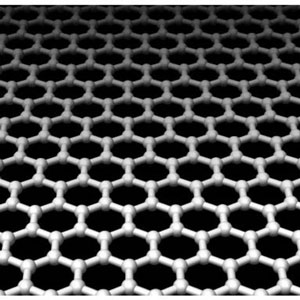| Posted: October 16, 2008 |
Unusual characteristics of graphene cold be explained by ripple structures |
|
(Nanowerk News) Graphene is a two-dimensional material that consists of a hexagonal array of carbon just one atom thick. Although it is essentially just a single sheet of graphite, its properties are remarkable and unique. Notably, its charge carriers behave like massless relativistic particles, and move at a speed of just 300 times less than the speed of light—many times more quickly than in silicon. This makes graphene a potentially attractive alternative to silicon as future computer chips.
|
|
Many questions remain about graphene. A numerical study conducted by an international team of physicists including Akira Furusaki of RIKEN's Advanced Science Institute in Wako, attempts to explain the unusual quantum Hall effect that arises in graphene, and the influence of disorder of its 2D structure on its behavior ("Quantum Hall Effect of Massless Dirac Fermions in a Vanishing Magnetic Field").
|
 |
| Graphene consists of a single layer of carbon atoms arranged in a hexagonal array. Its structure and two-dimensional nature gives rise to its unique and potentially useful electronic characteristics.
|
|
The quantum Hall effect occurs in metal-like systems whose electrons are confined to move only in a two-dimensional plane. It is characterized by the emergence of plateaus in the conductance measured transverse to the flow of current through the system—known as the Hall conductance—when a large magnetic field is applied through the plane.
|
|
In graphene, the quantum Hall effect is subtly different to that in other 2D systems. Normally, the Hall conductance begins at zero and increases in exact increments, described as e2/h, with increasing magnetic field or charge concentration. In graphene, however, the conductance changes in multiples of 4e2/h and the whole characteristic is shifted by half this value.
|
|
Moreover, in most systems it is usually destroyed by disorder or by thermal fluctuations at temperatures much above absolute zero. But in graphene, it is remarkably insensitive to both, with the Hall plateaus around zero conductivity evident all the way up to room temperature.
|
|
The simulations performed by Furusaki and colleagues suggest that the robustness of the quantum Hall effect in graphene arises as a result of the relativistic nature of its charge carriers. Under certain amounts of disorder, the wavefunctions of zero-energy carrier states do not become localized in the same way as those of nonrelativistic carriers in conventional quantum Hall systems would. The researchers argue that the occurrence of such nonlocalized states—known as critical states—could explain why the initial Hall plateaus occur at +/- 2e2/h, rather than at zero before increasing in multiples of 4e2/h. Moreover, they argue that the expected occurrence of ripples in graphene's structure could be enough to cause these nonlocalized states to emerge.
|

